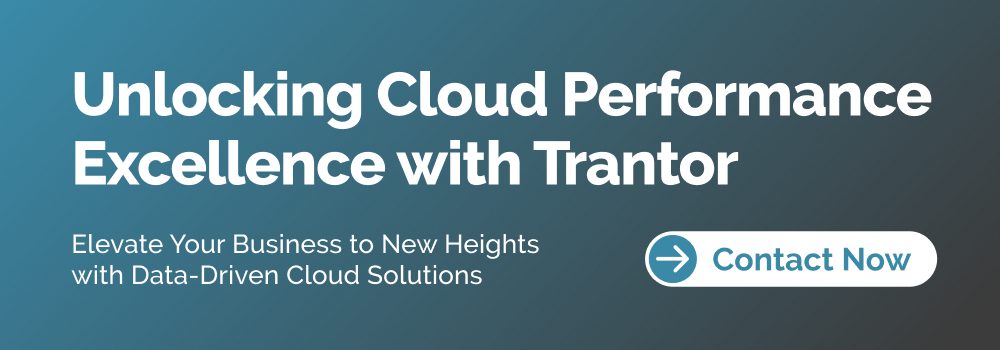Cloud, zBlog
AWS vs Google Cloud vs Azure: Performance Battle
atif | Updated: October 19, 2023
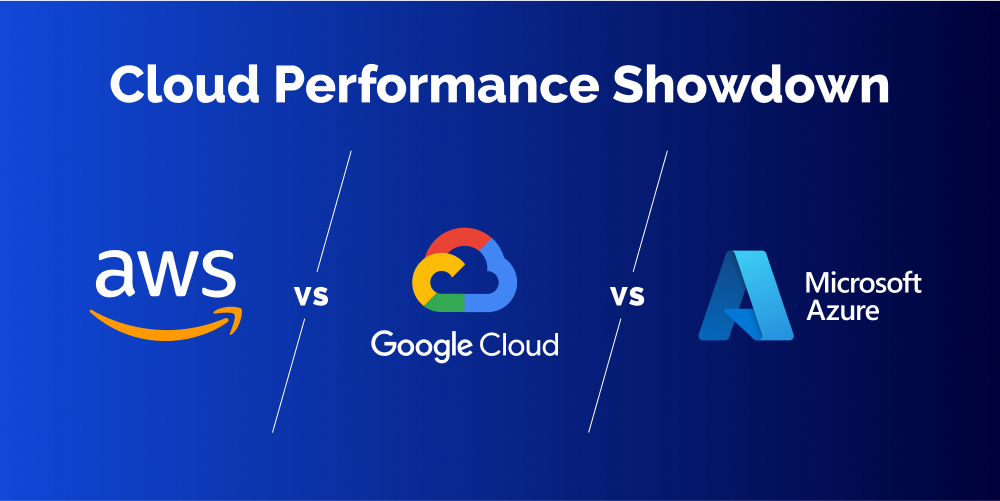
Introduction – AWS vs Google Cloud vs Azure
The cloud computing market is booming, with no signs of slowing down. Top players like Amazon Web Services (AWS), Google Cloud Platform (GCP), and Microsoft Azure continue to innovate and expand their global infrastructure to meet surging demand. In this blog, we’ll dive into the performance capabilities of the “Big 3” cloud providers—AWS vs Google Cloud vs Azure.
With so many options, how do you determine the best cloud platform for your business? Performance is a key factor. You want lightning-fast speeds, high availability, and the ability to scale seamlessly.
You’ll learn how they stack up in critical areas like compute power, network throughput, and scalability. We’ll also explore real-world performance benchmarks.
Let’s compare these cloud titans and see which comes out on top for speed, reliability, and power.
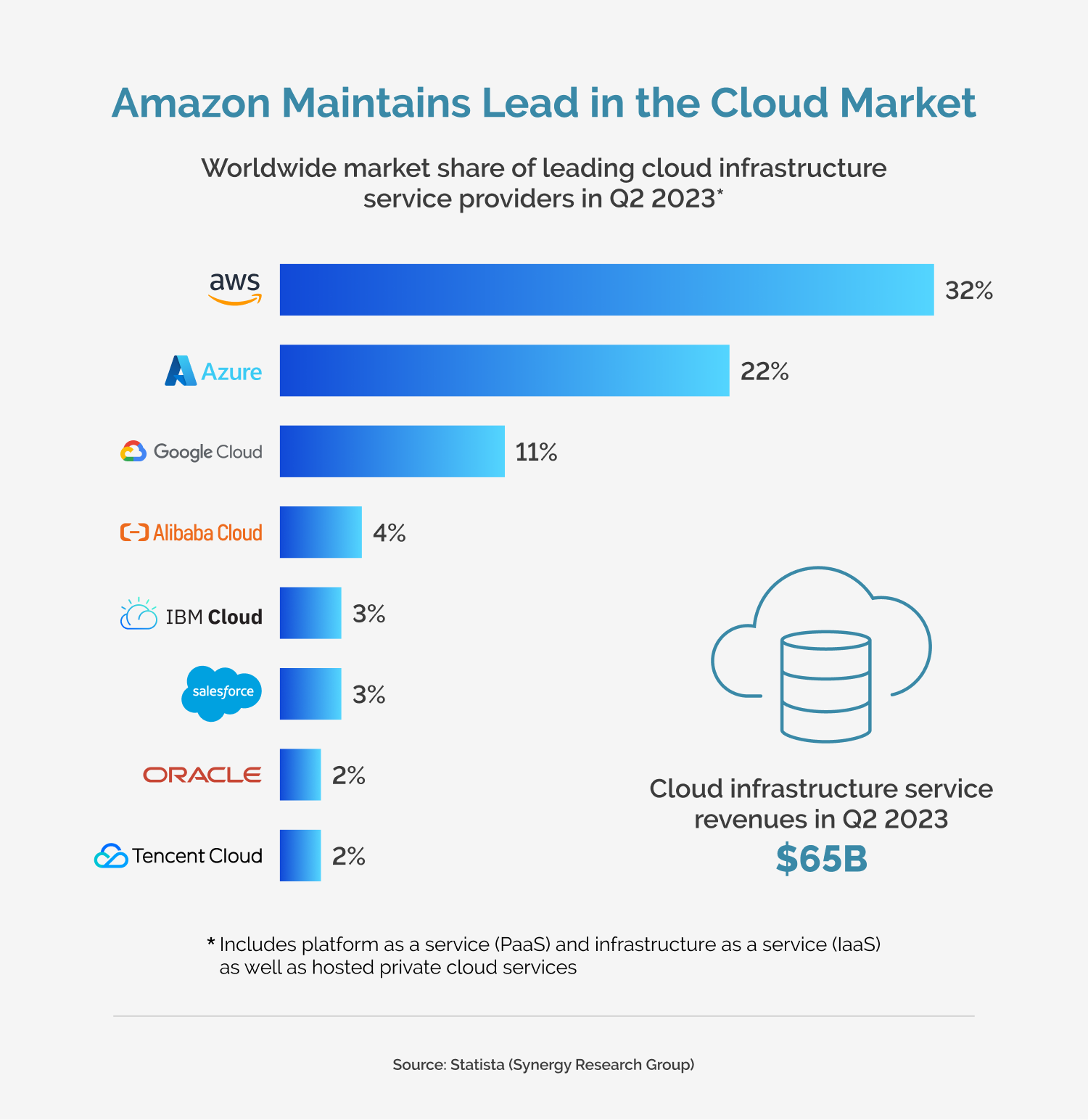
Size and Scale Matter
Performance starts with the physical infrastructure supporting these cloud platforms. AWS, Azure, and GCP operate a massive global network of data centers and edge locations. More infrastructure means they can distribute workloads optimally and replicate data to prevent downtime.
AWS Global Infrastructure
As the first major cloud provider, AWS has had over 15 years to build an expansive infrastructure. Today, AWS consists of:
- 25 geographic regions – More than any other cloud provider.
- 81 availability zones – At least three per region for high availability.
- 218+ edge locations – Local data centers for fast content delivery.
This vast reach enables AWS to offer industry-leading speed and resilience. Customers can deploy applications in whichever regions best serve their end users.
Microsoft Azure Data Centers
Microsoft Azure has quickly grown its infrastructure footprint worldwide. Key facts:
- 59 cloud regions – Second only to AWS.
- 163 data centers globally.
- 116 edge locations.
With dual data centers spread across 160 networks in 140 countries, Microsoft provides tremendous scale. They continue investing heavily to expand the Azure footprint.
Google Cloud Infrastructure
As the youngest cloud provider, Google Cloud Platform is playing catch-up in infrastructure. GCP currently operates:
- 27 cloud regions globally.
- 82 zones for high availability.
- 146 edge locations
While smaller than AWS and Azure, GCP’s network provides competitive speed and availability for most applications. Google constantly adds new regions and zones too.
Compute Power – The Engine of Performance
Virtual machines, containers, functions, and other computing options underlie everything you deploy to the cloud. Their CPU capacity and efficiency determine how fast your workloads run.
AWS EC2 Instance Types
The Amazon Elastic Compute Cloud (EC2) provides access to vast on-demand computing capacity. With EC2, you can launch hundreds or even thousands of virtual machine instances in minutes.
EC2 offers the most diverse selection of instance types among major cloud providers. Options are optimized for different use cases, including:
- General purpose (A, T, and M series)
- Compute-optimized (C series)
- Memory-optimized (R, X, and high memory series)
- Storage-optimized (I, D, and H series)
- Accelerated computing (P, G, and F series)
By selecting the ideal instance type for each workload, you can maximize performance and value.
Microsoft Azure Virtual Machines
Like AWS, Microsoft Azure provides virtual machines on-demand for Windows or Linux. Azure VMs deliver solid compute performance, backed by the Azure global infrastructure.
Key features include:
- Support for Windows, Linux, or custom images.
- Scalable VMs with up to 128 vCPUs and 448 GB of RAM
- Azure Disk Storage for fast-managed disks
- Integrated load balancing and autoscale capabilities.
For Windows applications, Azure Cloud Services provides even more performance and optimization options.
Google Compute Engine
The Google Compute Engine delivers virtual machines running on Google’s computing fabric. As you’d expect, GCP VMs excel at data analytics, machine learning, and other complex workloads.
Highlights include:
- Breadth of VM types optimized for different needs
- Local SSD and persistent Disk for fast I/O
- Autoscaling to meet demand spikes.
- Preemptible VMs for inexpensive batch computing
Compute Engine also integrates seamlessly with other GCP services for machine learning, big data, and more.
Network Throughput and Latency
Another vital performance metric is networking throughput and latency. You want your data flowing to and from the cloud at maximum speed.
Well-designed cloud networks overcome the limitations of physical distance through edge locations, routing optimization, and other techniques. Let’s examine each provider’s network capabilities.
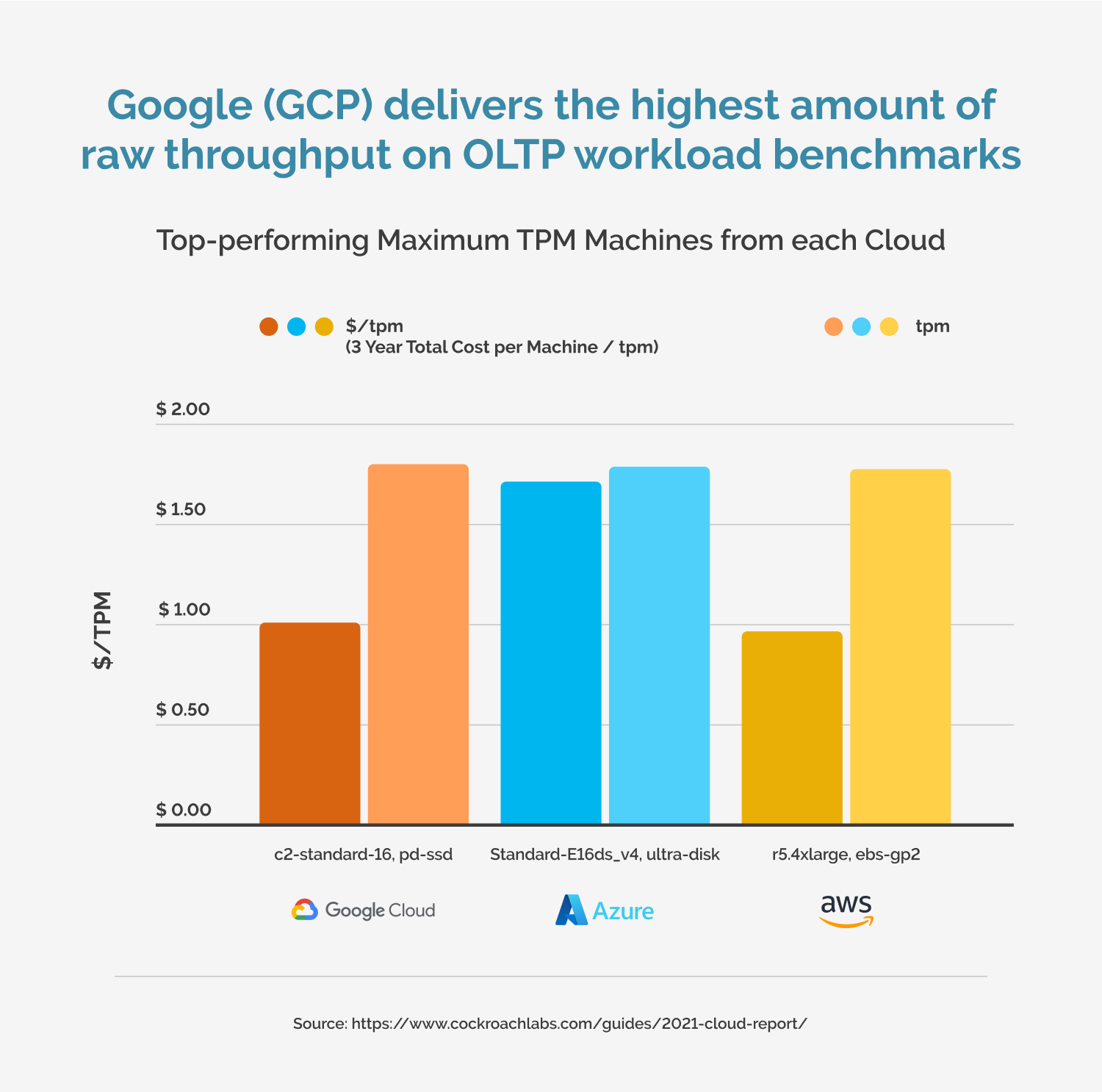
Amazon CloudFront and AWS Global Network
The Amazon CloudFront content delivery network provides blazing-fast throughput thanks to 225+ edge locations worldwide. CloudFront accelerates the delivery of static and dynamic content.
Meanwhile, the AWS global network achieves low latency and consistent performance across AWS services and EC2 instances. Optimized routes between regions deliver high transfer speeds.
Microsoft Azure Content Delivery Network
The Microsoft Azure Content Delivery Network (CDN) builds on Azure’s global edge infrastructure to cache content close to end users. Core benefits include:
- Faster delivery of website images, documents, and media.
- Dynamic site acceleration by caching site output at the edge.
- DDoS protection by absorbing malicious traffic at edge locations.
Azure consistently scores well in network throughput tests, thanks to its CDN integration.
Google Cloud Load Balancing
GCP does not offer a first-party CDN. However, it achieves low latency and high throughput through the extensive integration of Google Cloud Load Balancing across services.
Load balancing directs traffic optimally across GCP zones and regions to deliver:
- Consistent performance for web and mobile apps.
- Global scale and failover capabilities.
- Internal TCP/UDP load balancing.
As a result, applications see fast response times and resilience to traffic spikes.
Scalability and Elasticity
In the cloud, resources can scale up or down almost instantly to meet spikes and dips in demand. Flexible scalability makes the cloud far more efficient than on-premises data centers. Let’s explore how well each platform scales.
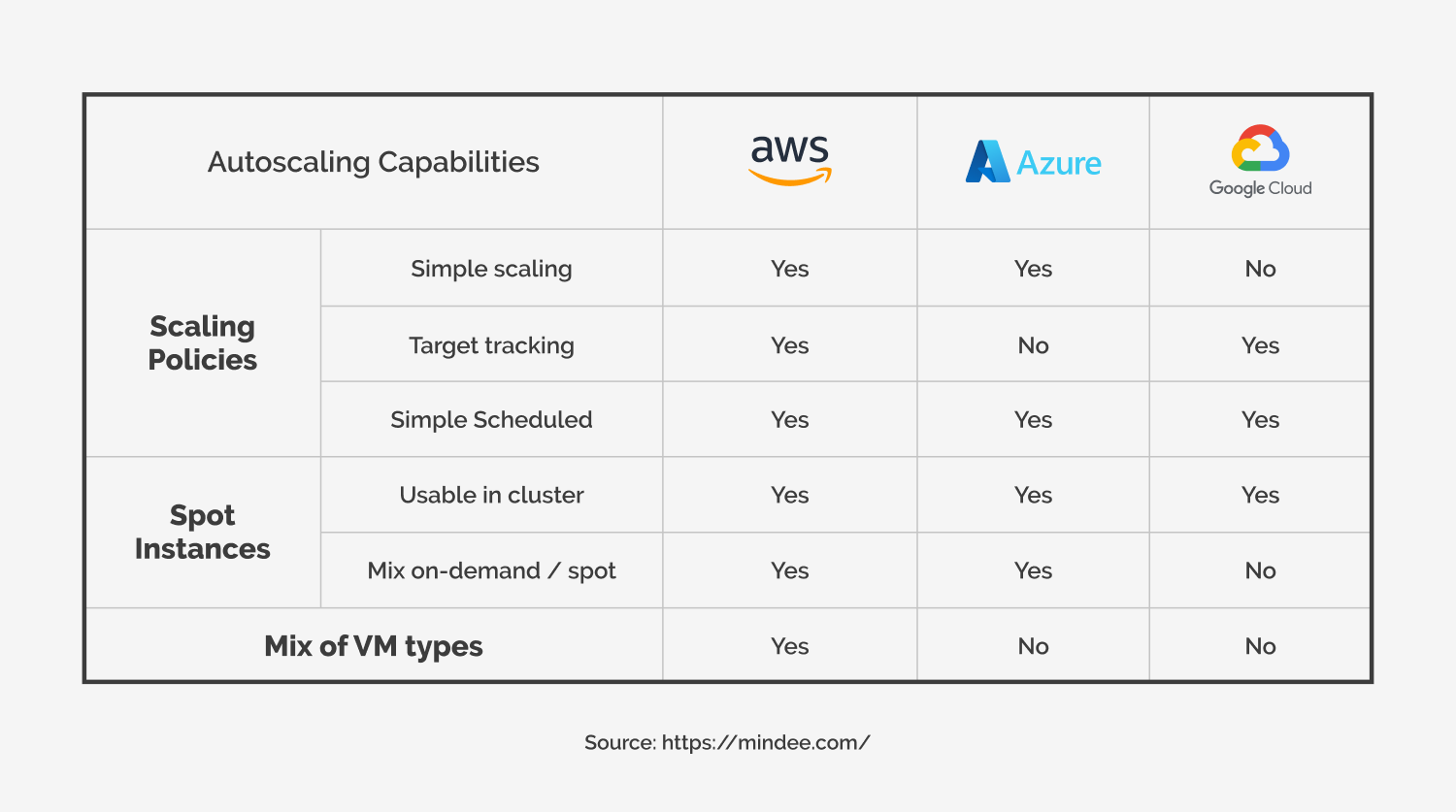
Auto Scaling with AWS
AWS provides multiple ways to autoscale resources to precisely match demand:
- EC2 Auto Scaling Groups – Automatically add or remove EC2 instances based on metrics.
- AWS Auto Scaling – Scale resources across services like DynamoDB.
- Application Auto Scaling – Scale resources programmatically using APIs.
Auto Scaling works smoothly across all AWS infrastructure worldwide. You can instantly grow capacity without performance drops.
Azure Virtual Machine Scale Sets
Azure Virtual Machine Scale Sets allow groups of load-balanced VMs to scale out efficiently. Key capabilities:
- Autoscale seamlessly from tens to thousands of VMs.
- Balance workloads evenly as VMs are added or removed.
- Control VM scaling using built-in or custom metrics.
Scale sets integrate tightly with the Azure Load Balancer for smooth scaling. Just define scaling rules and thresholds.
Google Cloud Auto Scaling
Like AWS and Azure, the Google Cloud Platform enables automated scaling in response to demand changes. Specifically:
- Compute Engine Managed Instance Groups support autoscaling clusters of VMs.
- App Engine automatically scales your web apps.
- Kubernetes Engine autoscales clusters based on utilization.
GCP auto-scaling works across infrastructure globally to dynamically allocate just the right amount of resources.
Real-World Performance Benchmarks
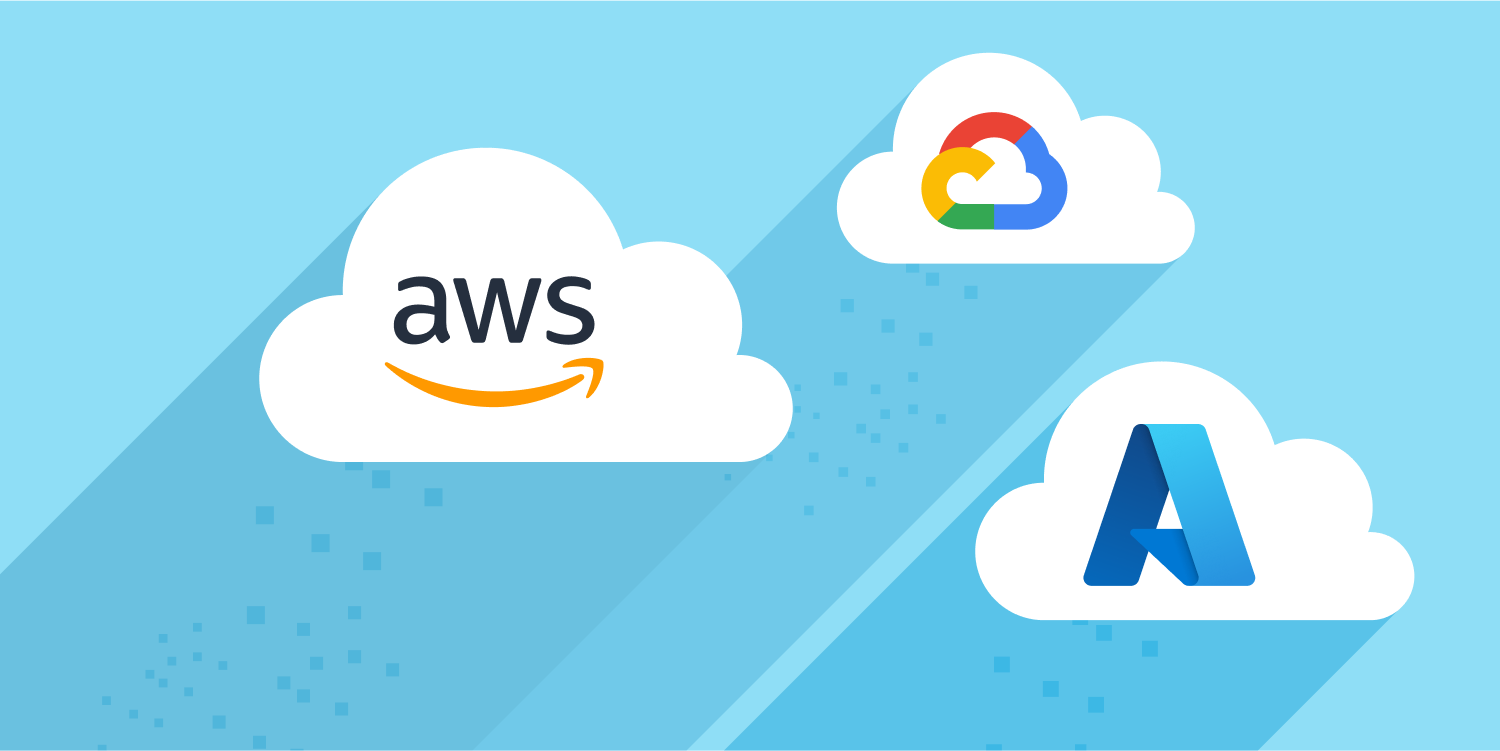
Now that we’ve compared architectures and capabilities, let’s examine some real-world performance benchmarks. Independent tests provide insights into actual speeds across platforms.
While performance varies case by case, some key patterns emerge:
- AWS achieves the fastest network throughput,thanks to its massive infrastructure and optimizations like CloudFront.
- Azure earns excellent marks for computing power and scalability. Its tight integration with Microsoft software is a plus.
- GCP shines for advanced workloads involving machine learning, data analytics, and visualization.
GCP auto-scaling works across infrastructure globally to dynamically allocate just the right amount of resources.
Let’s look at findings from a few reputable benchmarks:
CloudSpectator 2019 Benchmarks – Higher is Better
- AWS led in 7 out of 10 metric categories, like CPU and memory performance. Azure outperformed in two categories while tying AWS in one.
- AWS had the fastest disk write speed at nearly 1 Gbps.
- Azure displayed the fastest networking speed from North America to APAC.
Netflix 2018 Benchmarks – Higher is Better
- AWS had the fastest network throughput by a large margin.
- AWS also led for compute performance, while Azure was faster for memory reads.
- GCP delivered strong processing power despite a smaller infrastructure.
While all three platforms are highly capable, AWS leads in overall speed and network performance. However, benchmarks alone shouldn’t dictate your choice. Also consider costs, ecosystems, developer tools, and other factors.
Pricing comparison: AWS vs Google Cloud vs Azure
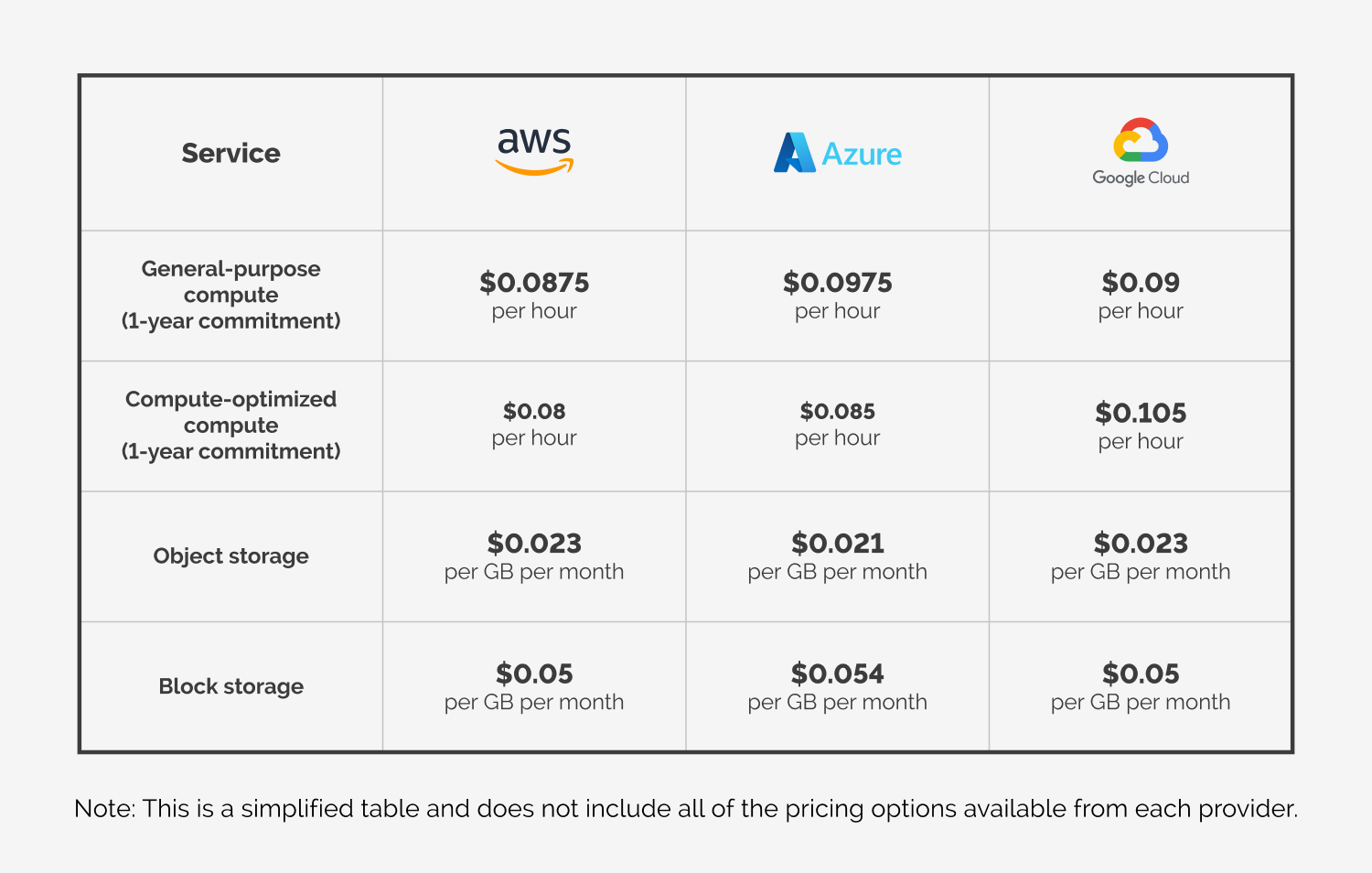
As you can see, the pricing for AWS, Azure, and Google Cloud is very similar. However, there are some minor differences. For example, AWS is slightly cheaper for general-purpose compute, while Azure is slightly cheaper for compute-optimized compute. Object storage and block storage are the same price for all three providers.
It is important to note that the pricing for cloud services can vary depending on a number of factors, such as the region you are using, the type of instance you are using, and the amount of data you are storing. It is important to use the pricing calculators provided by each cloud provider to get an accurate estimate of your costs.
In addition to the pricing for individual services, all three cloud providers offer a variety of discounts and savings options. For example, you can save money by committing to a reserved instance or by using sustained-use discounts. You can also save money by using managed services or by using the cloud provider’s native tools.
When choosing a cloud provider, it is important to consider your specific needs and requirements. You should also factor in the pricing and the discounts and savings options that are available.
AWS vs Google Cloud vs Azure – Cloud Performance
Here are some top lessons regarding performance across AWS, Azure, and GCP:
- AWS – Fastest network throughput thanks to massive infrastructure and CDN. Top choice if speed is the priority.
- Azure – Excellent all-around performance and a seamless Windows ecosystem. Ideal for Microsoft-centric organizations.
- GCP – Leading advanced analytics and ML capabilities. A great choice for data-driven apps.
- Hybrid cloud – Mixing cloud providers may offer the best performance for different workloads.
- Rightsize resources – Using optimal instance types and features ensures cost efficiency.
- Test rigorously – Profile performance before deploying to production to validate choices.
- Monitor closely – Track metrics like latency and error rates to catch any dips.
- Use auto-scaling – Scale resources up and down in real-time to maintain speed.
By following best practices and optimizing workloads, you can achieve blazing-fast application performance of AWS vs Google Cloud vs Azure.
The cloud arena keeps evolving. Providers rapidly expand capabilities and drop prices to stay competitive. Evaluate them continuously to ensure you choose the right platform as business needs change.
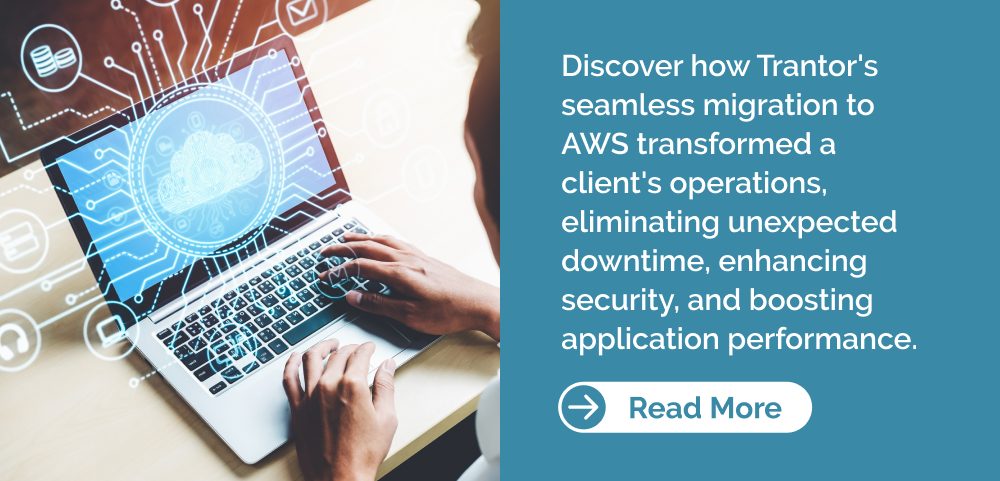
Making the Optimal Cloud Performance Choice
With this analysis in your toolbox, you have the insights needed to select the ideal cloud provider for performance. Remember to look at the big picture, including:
- Infrastructure footprint and scaling capacity.
- Compute, network, and storage throughput.
- Latency and responsiveness.
- Management, automation, and optimization capabilities.
- Costs and anticipated growth trajectory
- Ease of migration and integration with systems.
- Security, compliance, and governance needs.
For most organizations, a multi-cloud approach combining two or more platforms may be the best fit. This prevents vendor lock-in while leveraging each cloud’s strengths.
Modern applications use technologies like containers and microservices that make distributed deployments across clouds practical. Invest in skills to integrate AWS, Azure, and GCP seamlessly.
The cloud arena is always changing. As you plan your cloud migration and adoption roadmap, remain objective. Don’t get swayed by vendor hype and marketing. Analyze hard performance, cost, and feature data.
Choose the right cloud platform for each workload. Implement governance to manage a secure, efficient multi-cloud environment over the long-term. With the agility the cloud enables, you can continuously optimize performance and costs.
Embracing the cloud confidently and strategically will maximize your chance of gaining a competitive advantage. Learn all you can about crunching performance numbers – it’s the best way to ensure success.
Migrate to the cloud with Trantor
As we’ve seen in this extensive comparison of AWS vs Google Cloud vs Azure, each have unique strengths when it comes to cloud performance. The right choice depends on your specific priorities and workload.
For organizations looking to migrate to the cloud, expert guidance is critical to ensuring maximum performance. This is where partners like Trantor prove invaluable.
Trantor offers full-scale AWS migration services to transition your infrastructure, databases, applications, and workloads seamlessly to the cloud. Our certified AWS experts will architect a customized migration approach to meet your needs for security, compliance, and optimal performance.
With Trantor, you benefit from proven methodologies, zero downtime migrations, accelerated timelines, and comprehensive ongoing management. Our goal is to migrate you swiftly while optimizing costs.
Our consultants become an extension of your team to deliver a smooth, secure transition that unlocks the performance potential of AWS. With the right partner, you can migrate confidently and realize the benefits of the cloud faster. Contact Trantor today to get started on your high-performance AWS migration journey. Our experience with complex enterprise transitions will ensure your success.
